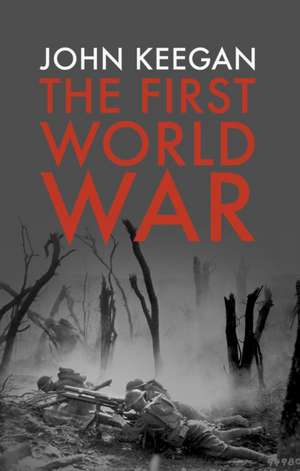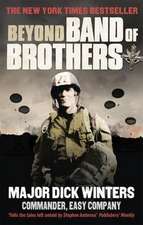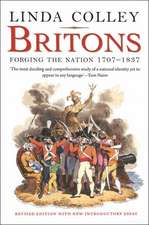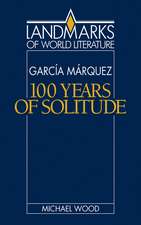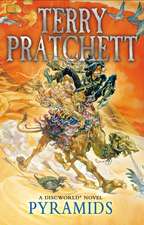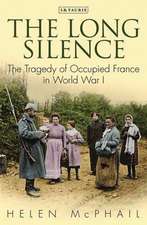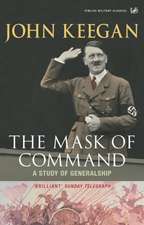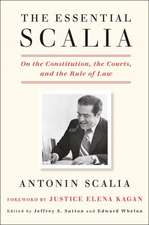The First World War
Autor John Keeganen Limba Engleză Paperback – 30 ian 2014
| Toate formatele și edițiile | Preț | Express |
|---|---|---|
| Paperback (2) | 112.37 lei 26-32 zile | +48.12 lei 7-13 zile |
| Vintage Publishing – 30 ian 2014 | 112.37 lei 26-32 zile | +48.12 lei 7-13 zile |
| Vintage Books USA – 30 apr 2000 | 131.37 lei 3-5 săpt. |
Preț: 112.37 lei
Preț vechi: 130.40 lei
-14% Nou
Puncte Express: 169
Preț estimativ în valută:
21.50€ • 22.45$ • 17.80£
21.50€ • 22.45$ • 17.80£
Carte disponibilă
Livrare economică 20-26 martie
Livrare express 01-07 martie pentru 58.11 lei
Preluare comenzi: 021 569.72.76
Specificații
ISBN-13: 9781847922984
ISBN-10: 1847922988
Pagini: 544
Dimensiuni: 154 x 233 x 45 mm
Greutate: 0.73 kg
Editura: Vintage Publishing
ISBN-10: 1847922988
Pagini: 544
Dimensiuni: 154 x 233 x 45 mm
Greutate: 0.73 kg
Editura: Vintage Publishing
Notă biografică
John Keegan was for many years the senior lecturer in military history at the Royal Military Academy, Sandhurst. He lives in Wiltshire, England.
Extras
From Chapter One: A European Tragedy
The First World War was a tragic and unnecessary conflict. Unnecessary because the train of events that led to its outbreak might have been broken at any point during the five weeks of crisis that preceded the first clash of arms, had prudence or common goodwill found a voice; tragic because the consequences of the first clash ended the lives of ten million human beings, tortured the emotional lives of millions more, destroyed the benevolent and optimistic culture of the European continent and left, when the guns at last fell silent four years later, a legacy of political rancour and racial hatred so intense that no explanation of the causes of the Second World War can stand without reference to those roots. The Second World War, five times more destructive of human life and incalculably more costly in material terms, was the direct outcome of the First. On 18 September 1922, Adolf Hitler, the demobilised front fighter, threw down a challenge to defeated Germany that he would realise seventeen years later: "It cannot be that two million Germans should have fallen in vain . . . No, we do not pardon, we demand--vengeance!"
The monuments to the vengeance he took stand throughout the continent he devastated, in the reconstructed centres of his own German cities, flattened by the strategic bombing campaign that he provoked, and of those--Leningrad, Stalingrad, Warsaw, Rotterdam, London--that he himself laid waste. The derelict fortifications of the Atlantic Wall, built in the vain hope of holding his enemies at bay, are monuments to his desire for vengeance; so, too, are the decaying hutments of Auschwitz and the remnants of the obliterated extermination camps at Sobibor, Belzec and Treblinka. A child's shoe in the Polish dust, a scrap of rusting barbed wire, a residue of pulverised bone near the spot where the gas chambers worked, these are as much relics of the First as of the Second World War. They have their antecedents in the scraps of barbed wire that litter the fields where the trenches ran, filling the French air with the smell of rust on a damp morning, in the mildewed military leather a visitor finds under a hedgerow, in the verdigrised brass of a badge or button, corroded clips of ammunition and pockmarked shards of shell. They have their antecedents also in the anonymous remains still upturned today by farmers ploughing the bloodsoaked soil of the Somme--"I stop work at once. I have a great respect for your English dead"--just as the barely viewable film of bodies being heaped into the mass graves at Belsen in 1945 has its antecedents in the blurred footage of French soldiers stacking the cordwood of their dead comrades after the Second Battle of Champagne in 1915. The First World War inaugurated the manufacture of mass death that the Second brought to a pitiless consummation.
There are more ceremonial monuments. Few French and British communities lack a memorial to the dead of the Second World War. There is one in my West Country village, a list of names carved at the foot of the funerary crucifix that stands at the crossroads. It is, however, an addition and an afterthought. The cross itself was raised to commemorate the young men who did not return from the First World War and their number is twice that of those killed in the Second. From a population of two hundred in 1914, W. Gray, A. Lapham, W. Newton, A. Norris, C. Penn, L. Penn and W. J. White, perhaps one in four of the village's men of military age, did not come back from the front. Theirs are names found in the church registers that go back to the sixteenth century. They survive in the village today. It is not difficult to see from the evidence that the Great War brought heartbreak on a scale never known since the settlement was established by the Anglo-Saxons before the Norman Conquest and, thankfully, has not been known since. The memorial cross is, the church apart, the only public monument the village possesses. It has its counterpart in every neighbouring village, in the county's towns, where the names multiply many times, and in the cathedral of the diocese at Salisbury. It has its counterpart, too, in every cathedral in France, in each of which will be seen a tablet bearing the inscription, "To the Glory of God and in memory of one million men of the British Empire who died in the Great War and of whom the greater number rest in France."
Nearby, certainly, will stand a memorial to the locality's own dead, itself replicated in every surrounding town and village. France lost nearly two million in the Great War, two out of every nine men who marched away. They are often symbolised by the statue of a poilu, defiant in horizon blue, levelling a bayonet eastward at the German frontier. The list of names on the plinth is heartrendingly long, all the more heartrending because repetition of the same name testifies to more than one death, often several, in the same family. There are similar lists to be seen graven in stone in the towns and cities of most combatant nations of the Great War. Particularly poignant, I find, is the restrained classicism of the memorial to the cavalry division of the Veneto that stands beside the cathedral of Murano in the lagoon of Venice, bearing row after row of names of young men from the lowlands of the River Po who died in the harsh uplands of the Julian Alps. I am touched by the same emotion in the churches of Vienna where severe stone tablets recall the sacrifice of historic Habsburg regiments now almost forgotten to history.
The Germans, who cannot decently mourn their four million dead of the Second World War, compromised as the Wehrmacht was by the atrocities of the Nazi state, found a materially, if not morally equivalent difficulty in arranging an appropriately symbolic expression of grief for their fallen of the First, since so many lay on foreign soil. The battlefields of the east were closed to them by the Bolshevik revolution, those of the west made at best grudgingly accessible for the retrieval and reburial of bodies. The French and the Belgians found little room in their hearts or in the national soil for the creation of German war cemeteries.
The First World War was a tragic and unnecessary conflict. Unnecessary because the train of events that led to its outbreak might have been broken at any point during the five weeks of crisis that preceded the first clash of arms, had prudence or common goodwill found a voice; tragic because the consequences of the first clash ended the lives of ten million human beings, tortured the emotional lives of millions more, destroyed the benevolent and optimistic culture of the European continent and left, when the guns at last fell silent four years later, a legacy of political rancour and racial hatred so intense that no explanation of the causes of the Second World War can stand without reference to those roots. The Second World War, five times more destructive of human life and incalculably more costly in material terms, was the direct outcome of the First. On 18 September 1922, Adolf Hitler, the demobilised front fighter, threw down a challenge to defeated Germany that he would realise seventeen years later: "It cannot be that two million Germans should have fallen in vain . . . No, we do not pardon, we demand--vengeance!"
The monuments to the vengeance he took stand throughout the continent he devastated, in the reconstructed centres of his own German cities, flattened by the strategic bombing campaign that he provoked, and of those--Leningrad, Stalingrad, Warsaw, Rotterdam, London--that he himself laid waste. The derelict fortifications of the Atlantic Wall, built in the vain hope of holding his enemies at bay, are monuments to his desire for vengeance; so, too, are the decaying hutments of Auschwitz and the remnants of the obliterated extermination camps at Sobibor, Belzec and Treblinka. A child's shoe in the Polish dust, a scrap of rusting barbed wire, a residue of pulverised bone near the spot where the gas chambers worked, these are as much relics of the First as of the Second World War. They have their antecedents in the scraps of barbed wire that litter the fields where the trenches ran, filling the French air with the smell of rust on a damp morning, in the mildewed military leather a visitor finds under a hedgerow, in the verdigrised brass of a badge or button, corroded clips of ammunition and pockmarked shards of shell. They have their antecedents also in the anonymous remains still upturned today by farmers ploughing the bloodsoaked soil of the Somme--"I stop work at once. I have a great respect for your English dead"--just as the barely viewable film of bodies being heaped into the mass graves at Belsen in 1945 has its antecedents in the blurred footage of French soldiers stacking the cordwood of their dead comrades after the Second Battle of Champagne in 1915. The First World War inaugurated the manufacture of mass death that the Second brought to a pitiless consummation.
There are more ceremonial monuments. Few French and British communities lack a memorial to the dead of the Second World War. There is one in my West Country village, a list of names carved at the foot of the funerary crucifix that stands at the crossroads. It is, however, an addition and an afterthought. The cross itself was raised to commemorate the young men who did not return from the First World War and their number is twice that of those killed in the Second. From a population of two hundred in 1914, W. Gray, A. Lapham, W. Newton, A. Norris, C. Penn, L. Penn and W. J. White, perhaps one in four of the village's men of military age, did not come back from the front. Theirs are names found in the church registers that go back to the sixteenth century. They survive in the village today. It is not difficult to see from the evidence that the Great War brought heartbreak on a scale never known since the settlement was established by the Anglo-Saxons before the Norman Conquest and, thankfully, has not been known since. The memorial cross is, the church apart, the only public monument the village possesses. It has its counterpart in every neighbouring village, in the county's towns, where the names multiply many times, and in the cathedral of the diocese at Salisbury. It has its counterpart, too, in every cathedral in France, in each of which will be seen a tablet bearing the inscription, "To the Glory of God and in memory of one million men of the British Empire who died in the Great War and of whom the greater number rest in France."
Nearby, certainly, will stand a memorial to the locality's own dead, itself replicated in every surrounding town and village. France lost nearly two million in the Great War, two out of every nine men who marched away. They are often symbolised by the statue of a poilu, defiant in horizon blue, levelling a bayonet eastward at the German frontier. The list of names on the plinth is heartrendingly long, all the more heartrending because repetition of the same name testifies to more than one death, often several, in the same family. There are similar lists to be seen graven in stone in the towns and cities of most combatant nations of the Great War. Particularly poignant, I find, is the restrained classicism of the memorial to the cavalry division of the Veneto that stands beside the cathedral of Murano in the lagoon of Venice, bearing row after row of names of young men from the lowlands of the River Po who died in the harsh uplands of the Julian Alps. I am touched by the same emotion in the churches of Vienna where severe stone tablets recall the sacrifice of historic Habsburg regiments now almost forgotten to history.
The Germans, who cannot decently mourn their four million dead of the Second World War, compromised as the Wehrmacht was by the atrocities of the Nazi state, found a materially, if not morally equivalent difficulty in arranging an appropriately symbolic expression of grief for their fallen of the First, since so many lay on foreign soil. The battlefields of the east were closed to them by the Bolshevik revolution, those of the west made at best grudgingly accessible for the retrieval and reburial of bodies. The French and the Belgians found little room in their hearts or in the national soil for the creation of German war cemeteries.
Recenzii
"Eloquent.... Mr. Keegan captures the anamolous, even surreal quality of the war." -The New York Times
"The best one-volume account there is." -Civilization
"Elegantly written, clear, detailed, and omniscient.... Keegan is ...perhaps the best military historian of our day." -The New York Times Book Review
"Undoubtedly the world's most accessible and popular military historian." -Los Angeles Times Book Review
"Magisterial.... A miracle of concision." -The Weekly Standard
"An epic tale.... Makes us keenly aware of how battles are fought, won, and lost." -Fortune
"The best one-volume account there is." -Civilization
"Elegantly written, clear, detailed, and omniscient.... Keegan is ...perhaps the best military historian of our day." -The New York Times Book Review
"Undoubtedly the world's most accessible and popular military historian." -Los Angeles Times Book Review
"Magisterial.... A miracle of concision." -The Weekly Standard
"An epic tale.... Makes us keenly aware of how battles are fought, won, and lost." -Fortune
